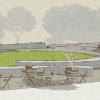100 Prince and Infill Housing Regulations Move Forward
City Dope

Photo Credit: Smith Planning Group
The 100 Prince Development would include small apartment buildings along single-family Childs Street.
Planning commissioners last week unanimously approved redevelopment plans for St. Joseph Catholic Church on Prince (for the second time, since the developer pulled and then resubmitted the plans).
If ACC commissioners approve, the chapel will become a restaurant, other existing buildings will be demolished, and two four-story brick apartment buildings (one behind the other, plus a parking deck) will be built, including ground-floor commercial space facing Prince Avenue. That could include a small supermarket—“at least that’s today’s plan,” petitioner Jim Warnes told the Planning Commission. And seven smaller apartment buildings will be built farther back on the six-acre property.
Neighbors (including the Boulevard Neighborhood Association) have generally supported the plan, and planning commissioners saw it as a reasonable transition between downtown and Prince Avenue.
Neighbor Laura Steadman didn’t agree; it’s a “bloated vision,” she said, that “will set the precedent for what will come down Prince.”
Infill Regs: Pushed by planning commissioners to develop rules limiting out-of-scale new “McMansions” in existing neighborhoods, ACC Senior Planner Bruce Lonnee offered several proposals to the Planning Commission last week, including limiting the size of the “envelope” that regulations require a house to be built within.
Requiring further setbacks from the property lines, especially for taller houses, would limit house sizes on modest lots, and would be “remarkably different from what the code allows today,” Lonnee said. Planning staffers are also proposing a four-foot-high limit on any retaining walls built within required setback areas.
Also proposed: “context-sensitive design” districts where regulations would vary by neighborhood. Regulations already allow for such overlay districts, which could be developed with input from neighborhood residents and administered by the Planning Department. “The sky’s the limit on what you can regulate” in such a district, Lonnee told Flagpole, but pinning down typical or acceptable neighborhood design elements can be hard, and some variation would be allowed.
Citizen input on such a system has been mixed. “That’s where we got a lot of our comments, pro and con,” Lonnee said. Several hundred people have commented online or attended public meetings on the various infill proposals—an unusually high level of interest.
The suggested infill rules will be honed for the Planning Commission’s September meeting and must eventually be approved by the elected ACC commissioners.
Due to “considerable public interest” in “tiny” houses—which can be as small as 100 square feet—a review of relevant local regulations will also be developed. Now, multiple cottages as small as 450 square feet can be built on land zoned multifamily, but 600 square feet is the minimum for single-family homes, Lonnee told Flagpole. While campers or custom-built trailers can be smaller (and can be parked indefinitely in a driveway), no one is allowed to live in them, he said.












comments